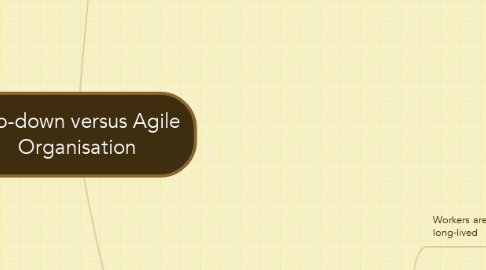
1. Traditional top-down hierarchical organisation
1.1. Top-level exec believe that for org to succeed:
1.1.1. They need to be able to make smart decisions and be in control
1.1.1.1. “It’s a hard job but that’s what we’ve been hired to do”
1.1.1.2. "... besides how possibly could an individual worker have a broad enough perspective to make smart decisions"
1.1.2. Their job, as they see it, is to provide structure, guidance and focus to workers by making tough decisions and enforcing policies and processes
1.2. In order to achieve and maintain control
1.2.1. They demand clear paths of accountability
1.2.1.1. Potentially leading to inordinate time and effort spent on setting and resetting reporting lines in the org structure
1.2.2. They require a plethora of managers and middle managers to be able to reach all the workers and to manage all the work
1.2.2.1. Through budgets, managers are delegated power and influence
1.2.2.2. By imposing deadlines and providing information on a need-to-know basis, workers are kept focused on delivering the projects
1.2.2.2.1. workers are seen as producers, not co-creators, nor knowledge workers
1.3. In order to make smart and informed decisions and to get insights into how things are progressing
1.3.1. They request status reports and relevant data
1.3.1.1. For reasons of efficiency, reports, processes and tools are standardised
1.3.1.1.1. Such standardisation is not usually helpful for the people doing the actual work, giving them additional burdens
1.3.1.1.2. Bureaucratic behaviour ensues to enforce the policies and processes with little value add
1.3.1.2. For reasons of simplification and abstraction
1.3.1.2.1. information is lost or distorted
1.3.1.2.2. As such, the divide between the top-level exec and reality is extended
2. Agile organisation
2.1. Workers are organised into teams that are long-lived
2.1.1. The work of the teams might vary over time but the work is always aligned to their mission
2.1.2. An agile team:
2.1.2.1. is cross-functional
2.1.2.1.1. which means that the members together have all the competencies needed to execute on their mission – from idea to customer deliverable
2.1.2.2. is collocated
2.1.2.2.1. which means that they sit physically to maximise communication and collaboration
2.1.2.3. has members who are fully dedicated
2.1.2.3.1. no other competing commitments
2.1.2.4. has sticky membership
2.1.2.4.1. It takes time for a team to become strong and high-performing
2.1.2.4.2. Frequently shuffling people around undermines that
2.1.2.5. is autonomous
2.1.2.5.1. They decide together:
2.1.2.5.2. Within the boundaries of their mission, they need to figure out the best strategy to reach their goals
2.1.2.5.3. They own and shape their own processes
2.1.2.5.4. They have a collective responsibility for the end-to-end quality of the products and services they deliver
2.1.2.5.5. To enable rapid learning, teams invest in establishing feedback loops – technical and customer validation
2.1.2.6. is adaptable
2.1.2.6.1. can evolve to changing needs
2.1.3. Each team governs themselves and makes decisions on a daily basis
2.1.3.1. For them to be able to do this
2.1.3.1.1. Teams need
2.2. Top-level execs believe that for the teams to succeed
2.2.1. The teams need them to provide clear guidance and support
2.2.1.1. Top-level execs don’t see themselves as being on top governing everyone beneath them
2.2.2. The teams need managers and middle managers whose job is to support them and make them successful
2.2.2.1. They provide feedback, support and guidance
2.2.2.2. They are not disconnected from the teams
2.2.2.3. They sit amongst the teams and listen in on meetings and discussions to provide support and close, active leadership
2.2.2.3.1. servant leadership
2.2.2.3.2. leaders as coaches
2.2.3. Top-level exec provide support but in a different way
2.2.3.1. They work to improve the overall health of the system and provide clear guidance on priorities
2.2.3.2. They intent to:
2.2.3.2.1. Deliver value to customers faster
2.2.3.2.2. Minimise bureaucracy
2.2.3.2.3. Minimise the distance between the decision makers and the source of information/expertise
2.3. Scaling the org is achieved by
2.3.1. groups of teams that
2.3.1.1. are related to a customer value stream
2.3.1.2. are related to a product family
2.3.1.3. ...
2.3.1.4. In other words, teams are formed around customer areas and NOT with the intent of establishing a clear line of command
